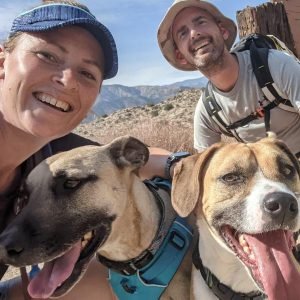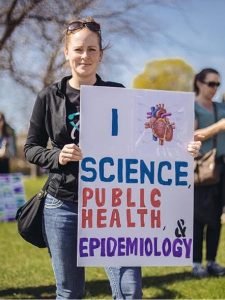Where did you grow up?
“I grew up in a small town called Des Lacs, ND, about one hour from the Canadian border. I am the middle of five kids and grew up working outside in any kind of weather with them, and playing sports. “

Tell us something about yourself that might be surprising.
“I am an ultrarunner and have fifteen 100+ mile races. This past March, I finished the 1,000 mile Iditarod Trail Invitational in Alaska, which is about the most extreme race for long-distance running and hiking there is.”
What inspired you to run 1,000 miles in the snow?
“When I first moved to Minnesota in 2010, I got really into trail running. I started running longer distances, then decided to try some winter races. I was really interested in those because they require you to be self-sufficient. You can’t rely on outside help. That got me invested in winter races and increasing the amount of miles I complete in them. Eventually that interest led me to try the Iditarod.
Throughout the first half of the Iditarod race, I was struggling. That was in part because of bad weather, and the whole experience was overwhelming. But when I hit the middle of the race, I felt my rhythm. Each day I would spend between 14-20 hours on the trail, and would sleep four to five hours a night. I would have to chop wood, melt snow, and do whatever was necessary to survive. And I finished it in 26 days and 19 hours! When I completed the Iditarod, I thought, ‘I am never doing this again.’ But it only took me about two weeks to start thinking about doing it again in the future.”
Wow. Amazing. What drew you to the field of public health?
“I received a research scholarship at UND during undergrad to research the effects of diabetes on the heart. From then on, I knew I wanted to do some sort of research, but I was not sure whether a lab environment was right for me. I moved around for a few years in the southern part of the U.S. and gained experience with health education and community public health while earning my MPH degree. I was drawn to epidemiology and saw it as a way to continue my research career and further study the heart and other cardiovascular outcomes using patient and study participant data as a way to test a research hypothesis.”

Tell me about your research.
“I am a cardiovascular epidemiologist. My research encompasses the prevention and prediction of cardiac and neurological events. It is mainly centered around the prediction and prevention of cardiac arrhythmias such as sudden cardiac arrest and atrial fibrillation.
I am currently investigating cardiovascular outcomes related to substance use, and looking at the combinations of substances with medications and detecting adverse outcomes that occur with people taking multiple medications while using substances.”
Why did you choose U of M SPH to accomplish your work?
“We have an excellent cardiovascular epidemiology program with faculty experts that are leading the field. I knew that I wanted to end up at SPH, so I worked as an analyst here for a few years before I pursued my PhD. We are at the center of several large cohort studies — including our Atherosclerosis Risk in Communities and Coronary Artery Risk Development in Young Adults studies — that look at cardiovascular health and aging, which is really exciting work.”
What classes do you teach?
“I teach PUBH 6346 and 6344, which are the Preparing and Completing the Integrated Learning Experience: Secondary Data Analysis classes. This set of courses are required for MPH students studying epidemiology to complete their final research project. Teaching these courses has been supportive to my growth as an instructor and researcher because I get to help students come up with their research projects. They have such innovative ideas that help me think differently.”
What is your favorite part about working with students?
“I get to see students’ projects from start to finish, which is really rewarding. I enjoy seeing their process and what they accomplish in their research. I also like getting to know students one-on-one throughout our time together — getting to know their goals, aspirations, and why they chose public health.”

